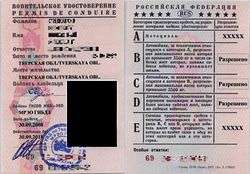Driving licence in Russia
_%D0%B2%D1%8B%D0%B4%D0%B0%D0%BD%D0%BD%D0%BE%D0%B5_%D0%B2_2011_%D0%B3%D0%BE%D0%B4%D1%83-%D0%BB%D0%B8%D1%86%D0%B5%D0%B2%D0%B0%D1%8F_%D1%81%D1%82%D0%BE%D1%80%D0%BE%D0%BD%D0%B0._%D0%9A%D0%B0%D0%B7%D0%B0%D0%BD%D1%8C.png)
_%D0%B2%D1%8B%D0%B4%D0%B0%D0%BD%D0%BD%D0%BE%D0%B5_%D0%B2_2011_%D0%B3%D0%BE%D0%B4%D1%83-%D0%BE%D0%B1%D1%80%D0%B0%D1%82%D0%BD%D0%B0%D1%8F_%D1%81%D1%82%D0%BE%D1%80%D0%BE%D0%BD%D0%B0._%D0%9A%D0%B0%D0%B7%D0%B0%D0%BD%D1%8C.png)

The Russian Empire was one of the first countries to create a driving licence. Russia's first licences were issued in 1900 by Saint Petersburg authorities, and Russia joined an international convention in 1909. However, due to relatively small number of cars, the attempts to create a standardised Russian licence were rather sporadic and limited to major urban areas. No comprehensive system of driver licensing was present until 1936, when the Soviet government organised and standardised traffic and driving regulations, with the state-wide system regulated by specialised police authorities.
Since March 2011[1] there are 9 categories that require a driving licence:
- A: any type of motorbike
- B: motorised vehicle under 3.5 tons (optionally with light trailer)
- C: motorised vehicle over 3.5 tons (optionally with light trailer, up to 750 kg)
- D: bus (has more than 8 passenger seats) (optionally with light trailer, up to 750 kg)
- BE: motorised vehicle under 3.5 tons with heavy trailer
- CE: motorised vehicle over 3.5 tons with heavy trailer
- DE: bus with heavy trailer
- Tram: tram
- Trolleybus: trolleybus
Currently Russia employs a system of driver's licences very similar to the EU standard with two additional categories:
- A2 similar to European A limited, as A does not limit the specs of motorbikes
- Bikes with engine displacements lower than 50 cc and speeds lower than 50 km/h are considered mopeds and doesn't require licence to drive
- B1 for tricycles and quadracycles.
The current licence style, introduced in 1999, is a laminated plastic card similar to the European driving licence card in dimensions and outward appearance, with the bearer's photo and name (in Latin and Cyrillic scripts) to the left, place/date of issue, allowed categories and signature to the right. The reverse of the card features a detailed list of allowed categories in Russian.[2] Older booklet-style licences are also occasionally seen although they are no longer issued and are increasingly rare as a result. The Russian driving licence is also sometimes supplemented by a special card called "временное разрешение" (temporary permission), which serves for registering offense points and as a temporary licence if the primary licence has been seized by the authorities for serious traffic offences.[3] This supplement has been abolished and reinstated a countless number of times as the views of the traffic police change.
The legal driving age within the Russian Federation is 18 years (16 for motorcycles and 20 for buses)[4] and to obtain a licence one must be physically fit to drive (including certificates of mental fitness and no record of substance abuse). One must also pass a test administered at a local traffic police authority and pay a fee. Tests are divided into theory and practice. The theory test is usually a computerized multiple-choice test on various traffic rules. Twenty multiple-choice questions are asked, only two incorrect answers allowed for a passing grade.[5] A road test is then administered which includes a demonstration of basic driving skills (steering, slope starting for manual transmission vehicles and backing-up), obstacle course as well as a skills examination for road driving. Four minor errors are allowed for the road driving examination—the obstacle course is pass-fail. The number of retries is unlimited.
Medical exceptions
In 2015, the BBC and many other media reported, that the Russian government adopted a decree that bans people with specific medical conditions according to the ICD-10 from holding a driving licence. The list is directly issued by the World Health Organization and it includes short people (dwarfism), transgender people, transvestites, fetishists, voyeurs, sadomasochists, pedophiles, exhibitionists, necrophiles, as well as pathological gamblers and kleptomaniacs.[6][7]
It was then later reported on Jan. 14, 2015 that the media reports were a hoax and that transsexuals are still able to drive.[8]
References
- ↑ RIA Novosti New Driver's Licence (in Russian)
- ↑ ForeignDocuments.com
- ↑ GAI.ru - Driving Licence
- ↑ We heart Moscow - Russian road rules
- ↑ GAI.ru - Driving Licence Examination
- ↑ "Russia says drivers must not have 'sex disorders'". BBC News. 8 January 2015. Retrieved 9 January 2015.
- ↑ "Sexual disorders listed as contradictions to driving in Russia". Russia Today. 9 January 2015. Retrieved 11 January 2015.
- ↑ The Moscow Times
| ||||||||||||||||||||||
| ||||||||||||||